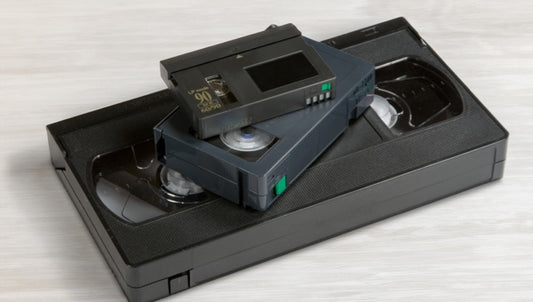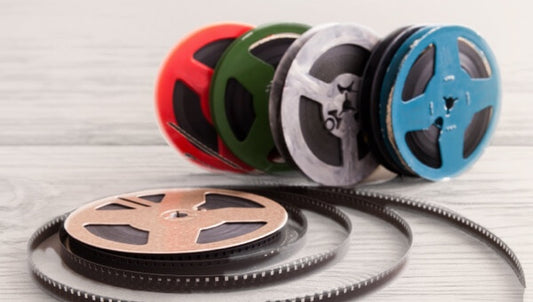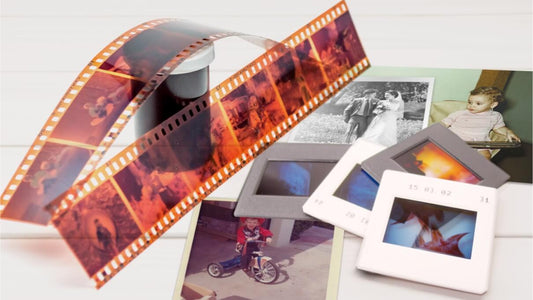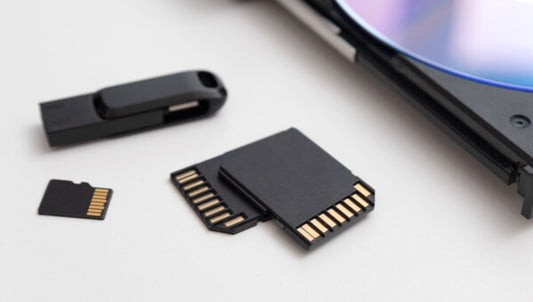Despite being two of the most preferred audio and video formats for years, many people still don’t know the differences between CD vs DVD. Knowing the similarities and differences can help you make the best choice for your memories, audio files, videos, and more.
With over 20 years of experience digitizing movies and creating digital and DVD copies of home movies, Capture put together this comprehensive guide to help you make the best choice for your precious memories.
Keep reading to learn about the history of CDs and DVDs as well as key differences in storage capacity, compatibility, quality, durability, prices, and more.
Jump to:
- CD and DVD History
- CD and DVD Storage Capacity
- CD and DVD Differences in Data Transfer Rates
- CD and DVD Compatibility
- CD and DVD Quality and Durability
- CD vs DVD for Different Types of Media
- Price Comparison
- Future of Optical Media
CD and DVD History

The history of the CD-ROM (also known as a compact disc if you’ve ever wondered “What does CD stand for?”) begins in 1957 with the rudimentary video disc. Over a decade later, Philips began working on the Audio Long Play (ALP) disc that used laser beam technology instead of the typical analog vinyl to produce longer sound capabilities.
This led to the 1978 Compact Disc Project by Philips and competition by Sony to jointly develop the audio CD that we recognize today. Over the next decade CD players became the standard for audio and other versions like CD-R and CD-RW entered the scene.
Then, in 1995, as a compromise between competing Multimedia CD (MMCD) and Super Density (SD) formats, the same two companies of Philips and Sony decided to agree on another common format, known as the DVD, an abbreviation for digital versatile disc or digital video disc.
Like CDs, DVD players led to recordable and rewritable DVDs called DVD-R and DVD-RW respectively. Other types use DVD technology like DVD-RAM or DVD-random access media.
Now that you know what does DVD stand for and the history of both formats, it’s important to understand what the R and RW additions mean. CD-R and DVD-R discs are used to record data a single time while CD-RW and DVD-RW can record and re-record data over and over. This is opposed to standard music CDs or movie DVDs that come pre-recorded and cannot be recorded over at all.
These two single disc formats were a major element of the shift from analog to digital that occurred throughout the late 1980s and into the 90s and 2000s. Before long, CDs had completely replaced audio cassettes and vinyl records and DVDs had replaced VHS videotapes.
While the technologies both used laser light to store data, CDs and DVDs are still separate formats with some major differences in functionality and usefulness.
CD and DVD Storage Capacity

One of the main differences and easiest ways how to tell if a disc is a CD vs DVD is storage capacity. This refers to how much space is on a CD vs DVD so if you have a copy that has an entire 2–3-hour movie on it, then you have a DVD.
On the other hand, if you have a disc that contains a handful of songs, then it’s likely you have a CD. A standard CD can store up to 700MB of data, which is around 80 minutes of audio, enough for a typical music album. This is also enough for 350 JPEG images.
A DVD can store significantly more data, up to 17GB. That equals around 5,304 minutes of audio or over 6 hours of video. This is because the bumps on a DVD-video disc are smaller and closer together, allowing for more digital data storage.
CDs have a spiral track spacing of 1.6 micrometers and .834 micrometers between each of the bumps while DVD discs offer around half those distances. Additionally, a DVD has a double layer while CDs only have a single reflective layer.
This dual layer of pits stores more data than the single layer of the older compact disc technology, which is one of the reasons that makes DVD a suitable option for movies and videos, while CDs are fine for audio and digital files.
CD and DVD Differences in Data Transfer Rates

Transferring data onto a CD-ROM or DVD-ROM takes time and is one of the differences between the formats, especially when comparing DVD-R vs CD-R differences. That’s because these types of discs are used for recording data.
A CD has a data transfer rate of 1.4 to 1.6 megabits per second, which was exceptionally fast for the time period they were popular, but it still takes some time to burn CDs. DVDs on the other hand offer a data transfer speed of 11 megabits per second, which is significantly faster.
This not only allows for faster recording and rewriting, but meant that videos, games, and interactive software releases often began to opt to use DVDs over CDs in the late 1990s and early 2000s. DVD drives were also faster, and this opened up more possibilities for rapidly changing or loading abilities.
CD and DVD Compatibility

For most people, the compatibility of a CD vs DVD is a major concern. While DVD players can play both DVDs and audio CDs, CD players are unable to play DVDs at all.
This is because, while DVDs and CDs use similar EFMP coding technologies, the DVD technology is updated to EFMPlus and designed for video capabilities. While DVD players are backward compatible, CD players were invented before DVD.
However, it’s important to note that standard DVD players will not play high-definition HD DVDs. That’s because standard DVDs use red lasers while HD-DVDs use 405 nanometers in the visible blue range with a shorter wavelength.
While many computer drives will play both CDs and DVDs, it’s certainly something to consider when you are deciding on which to use.
CD and DVD Quality and Durability

In general, DVDs will provide superior sound quality in addition to video capability. This is simply a case of better technology just like CDs offered better sound quality than vinyl, 8-tracks, and audio cassettes, DVDs improve upon the compact disc format.
However, when it comes to the durability and lifespan of CD vs DVD format, the answer depends on a few factors. All disc types including CDs, DVDs, and Blu-Ray discs have a coating layer, a reflective layer, and a polycarbonate recording layer that stores the data. Rewritable discs, like CD-RW and DVD-RW, have an extra dye layer between the protective and reflective layers.
Generally, recorded and rewritten media will degrade faster than those. While standard discs of both formats can last up to 200 years or longer, CD-Rs, CD-RWs, DVD-Rs, and DVD-RWs have a predicted lifetime of 20 to 100 years after they’ve been recorded. Before recording, they can last anywhere from 5 to 30 years depending on the type and brand.
So, if you’re wondering, “What is better DVD RW vs CD rewritable?” The answer is that the DVD might last longer prior to recording, but the lifespan is similar after they have recorded data. Since degradation typically consists of physical damage, oxidation or corrosion, or ultra-violet light damage, the best thing you can do is store discs in a cool, dry place.
CD vs DVD for Different Types of Media

In general, CDs are used for audio playback as well as simple data like short Java files, CIRC files, JPEGs, and written documents. DVDs offer more storage, which makes them the preferred format for movies, videos, games, and large amounts of data.
While DVDs can also store audio, there is one primary reason why you might want to choose CDs instead: affordability. Standard compact discs are much more affordable than the newer DVD format. Additionally, CD players are cheaper, which is why they are found more often in cars and with computers.
Plus, unless you are storing long movies or large amounts of data, then a CD should do just fine. However, keep storage capacity in mind when deciding on the best option for your photos, home movies, and other memories because a DVD will certainly hold much more.
Price Comparison

As mentioned, the price for CDs is quite a bit less than DVDs. While you lose some functionality, they’re perfect for audio and text files as well as photos as long as you don’t have too many. To give you a difference in the price, we compared the price of blank CD-Rs and CD-RWs to blank DVD-Rs and DVD-RWs.
100 CD-Rs cost anywhere from around $10 to around $35 whereas 100 DVD-Rs cost between $20 and $50. Then, for 100 DVD-RWs you will likely pay at least $50 while 100 CD-RWs are available for $25 to $40.
While the price difference may not seem significant, you also need to consider whether you have a DVD player and the ability to record onto blank DVDs. Many computers come standard with a recording CD drive, but you may have to buy a separate DVD player/recorder which can cost you $50 to $100+ more as well.
Future of Optical Media

After the release of DVDs that overtook VHS as the preferred video media format, there was a massive debate over Blu-Ray vs DVD. While Blu-Ray discs offered high definition compared to standard DVDs, even those are around 20 years old, so where will optical media technology take us next?
The first expectation is more storage capacity, which is already possible using certain file types. In addition, there may be improvements to the metal layer that allows for an entire library of music, movies, and data stored on a single disc.
While most people prefer using cloud storage these days, there are plenty of uses for a physical copy like as a gift or to pass down as an heirloom. Being able to store even more content on a single disc would make this more likely.
The next generations will also offer lower cost per bit, faster data transfer rates, automated error correction, and more. In fact, a start-up called Folio Photonics wants to create affordable 1TB optical discs. How they work is anybody’s guess because they patented their idea, but their goal is to revolutionize consumer physical media as well as business storage.
Conclusion
When it comes to CD vs DVD, there are some major differences including storage capacity, compatibility, preferred media, and more. In general, CDs are best for audio and small files while DVDs lend themselves to longer videos, movies, and video games.
If you have CDs or DVDs with precious memories like photos and home movies, then it’s important to back them up as digital files in the cloud or Google Photos. Capture can do this for you affordably and even convert your CDs, SD cards, and other digital media into digital format and convenient DVD copies complete with subtitles and chapters. Click here to learn more about our digital transfer services!










